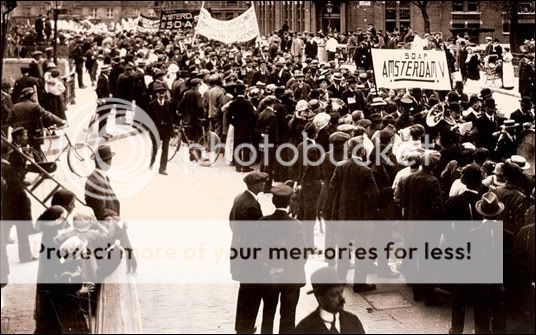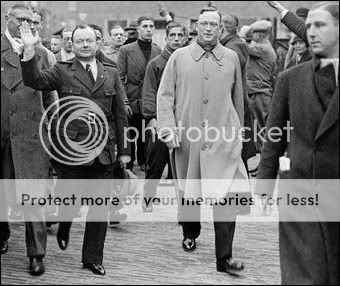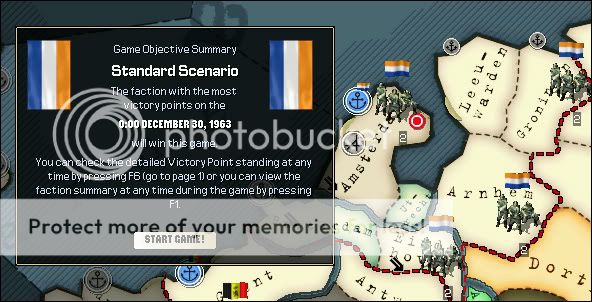1.6. Do you hear the people sing?

A major republican rally during the '34 elections
After the Reichstag got burned down in 1933, the prosecution of communists in Germany took a turn for the worse. As a German communist you could either go underground and oppose the government from there or flee the country. Many communists crossed the German-Dutch border to escape capture. The Dutch government tried to prevent it, but had neither the legislation nor the manpower to stop these remnants of the communistic party to enter the Netherlands. What attributed to this were the Republic minorities, who not only helped communists to cross the border but also gave them shelter. The interaction with the communist remnants influenced the frustrated republicans. Seeing democracy granting the Queen a more prominent positions made the republicans fear not just the monarchy, but the current parliamentarian democracy as well. 1933 also saw the amendment changes of the last Colijn-administration. Republicans were furious and all parties voted against the changes. The outrage was complete when during the vote it turned the fascist NSB was on the side of the government and voted for the changes. This made the republican no-votes irrelevant. Republicans thought the government no better than the fascists it got support from.
A major republican rally during the '34 elections
1934 saw new elections, the main issue was the Orange proposal as it was now named. The Republican parties focused their campaign on the issue and it was a moderate success. Compared to the 1930 elections the Republicans managed to steal votes away from both the Orangists and the NSB. Most of the Orangistic party votes came from the Christian community though. Being tradional voters a lot had to happen for them to change their vote. They also underestimated the popularity the government had generated. Their actions to battle the Great Depressions and the Sonderkonto had revitalized Dutch Industry. The economic growth guaranteed the elections for the Orangists. Wilhelmina suggested Dirk Jan De Geer, who had hold the position of Minister of Finance in the last Colijn administration. De Geer enjoyed respect from the socialistic parties for suggesting an unversial right to vote in 1909 and Wilhelmina hoped it would help the two sides to work out their differences. Although the Fascist party had lost seats in favor of the Republicans, the gain the Orangistic parties received was just enough to ensure that the second amendment vote was only a formality. The changes were decided to be put in action on the 1st January 1936. After the amendment changes were made public the republicans decided to work together and form the “Raad van Nederlandse Socialisten” comprising of all left wing parties. The CPN, the dutch communist party and the SDAP, the socialist party, were the two biggest parties inside the RNS. They started holding rallies and organizing strikes. The focus shifted from republican to a system similar to that of the Soviet Union.
The rise of communism did not go unnoticed, but the Dutch government did not respond as the Germans did. The government believed that even these people had a right to voice their opinion, even though they didn’t care for these communists much. The more violent outburst were being controlled by the police, but they had strict orders to only intervene when absolutely necessary. The government had not forgotten the public outcry during the Republic Riots and didn’t feel like making the same mistake twice.
The ones that did respond were the NSB. They started counter rallies against the communistic rallies. As the tensions between the two organizations grew, it came to clashes more and more often. Several times NSB members were accused of intentionally creating fights with the RNS sympathizers. Mussert felt, with the government not repressing the communistic movements, that he was now the protector of Dutch values against the Red threat. He tried calling upon the Orangistic government in the hopes of getting police support, but the government wasn’t ready to prosecute the communists actively. When trying to get an new audience with the Queen, it was refused. The official reasons were that his presence would be too much of a safety risk for Wilhelmina. In fact the Queen herself refused to talk to any of the parties involved until they were prepared to end the violence.

Mussert showing support for an anti-communistic rally in 1935
Not only did the NSB they start counter rallies, they started to investigate whereabouts of the German communists, who had the status of illegal immigrants. Most of these investigations led nowhere, because they just didn’t have the resources nor the authority to conduct proper investigation. Yet in the following years there were numerous incidents were RNS party officials found their homes ravaged. As a respond the RNS ransacked several buildings used by the NSB for official party gatherings.
Besides the growing amount of incidents between the NSB and the RNS 1935 saw a decline of the Sonderkonto agreement. Germany kept readjusting the armament plans, each one more ambitious and costly. Germany simply didn’t have the recourses or the money to repay the Netherlands. the Germanic agreement did keep the debt in check and effects on the Dutch economy were minimal. But the De Geer administration and Wilhelmina were worried that if the Germans kept missing payments the Dutch economy would stagnate, plans were drawn to increase industrial production inside the Netherlands. The goal was to create a stable more independent industry. Laws were written and approved. The ambitious project was to be put in action in 1936. The Starting signal would be the activation of the new Amendment Law. It announced that from now on the flag of the Netherlands was: blue-white-orange. These were the colors of the Republican flag, used during the Golden Age of Holland.

-------------------------------------------------
-See, an ingame screenshot! Who would have thought it. I unfortunaly like most people will have little time playing during the holidays, but hopefully I can get an update in there somewhere.
- Do you guys prefer counters or sprites for ingame screenshots? I didn't change the counters yet, but if people like them I'll change those aswell.
- YES, there is still one law left unmentioned, it will get a mention when it actually gets used
Last edited:


